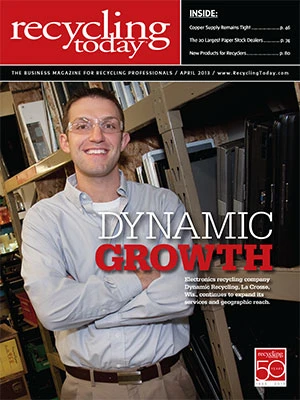
A “Green Fence” that China has erected to keep out undesirable material is having an effect on overseas purchases of secondary plastics. The country, in an effort to protect its environment, has launched an initiative it has dubbed Green Fence. As a result, Chinese customs officials are closely scrutinizing incoming shipments of recyclables, according to sources.
Low-grade materials in particular have felt the pinch. “Export buying activity has slowed for low-end grades of postconsumer plastics due to recent regulations and China’s green fence,” a reprocessor based in the Southwest says. He adds, “We are still actively exporting film grades and all industrial grade plastics as well as resin to Asia and Latin America.”
A reprocessor based in the Great Lakes region also points to China’s Green Fence as negatively affecting demand for some plastics.
“Mixed materials for export to China had demand slashed, as customs procedures have hampered buying,” he says. However, he adds that export to China for some grades of plastics, as well as to India, remain strong despite interruptions from Chinese New Year and tightened import restrictions in China.
“Dirty or mixed postconsumer materials, such as mixed rigid, are no longer shipped to China,” a recycler based in the Midwest says. “Chinese customs have targeted dirty materials, but they are also refusing materials such as woven PP Super Sacks, dirty LDPE (low-density polyethylene) and postconsumer bottles (HDPE, PP, PET, etc.). Material with metal, such as screw or wire-handled buckets, are also targeted.”
He adds, “Although export PET is still robust, it may be going to other countries than China.”
The Midwest recycler says the Green Fence in China means material is seeking domestic homes. He describes generation as better than normal for the time of year, given the relatively mild winter and an improving economy.
Generation has increased slightly in the packaging and automotive sectors, the reprocessor based in the Great Lakes region says. Demand also has experienced a bump in response to the increase in polyolefin pricing, he adds.
The reprocessor based in the Southwest says generation is somewhat soft, largely because manufacturers are being more efficient and reusing the scrap material they generate. “We do see an increase in the postconsumer plastics being collected and going into the marketplace, as we saw with the recycling rate increases for bottles collected,” he says, pointing to improved consumer awareness and more opportunities to recycle. He describes domestic demand for all secondary plastics as good as long as the material is of sufficient quality.
PET (polyethylene terephthalate), PS (polystyrene), PP (polypropylene) and PE (polyethylene) grades are growing in terms of demand, the reprocessor based in the Southeast says.
“We have calls daily looking for different types of material, especially PE and PP grades,” the recycler in the Midwest says. “Engineering grades are also in demand: PC, ABS (acrylonitrile butadiene styrene), PC/ABS, PVC and others.”
The reprocessor based in the Great Lakes region says the rising cost of freight in the last few months has created a value imbalance for some grades, eroding profitability.


Explore the April 2013 Issue
Check out more from this issue and find your next story to read.
Latest from Recycling Today
- Fenix Parts acquires Assured Auto Parts
- PTR appoints new VP of independent hauler sales
- Updated: Grede to close Alabama foundry
- Leadpoint VP of recycling retires
- Study looks at potential impact of chemical recycling on global plastic pollution
- Foreign Pollution Fee Act addresses unfair trade practices of nonmarket economies
- GFL opens new MRF in Edmonton, Alberta
- MTM Critical Metals secures supply agreement with Dynamic Lifecycle Innovations






